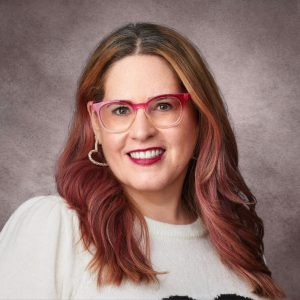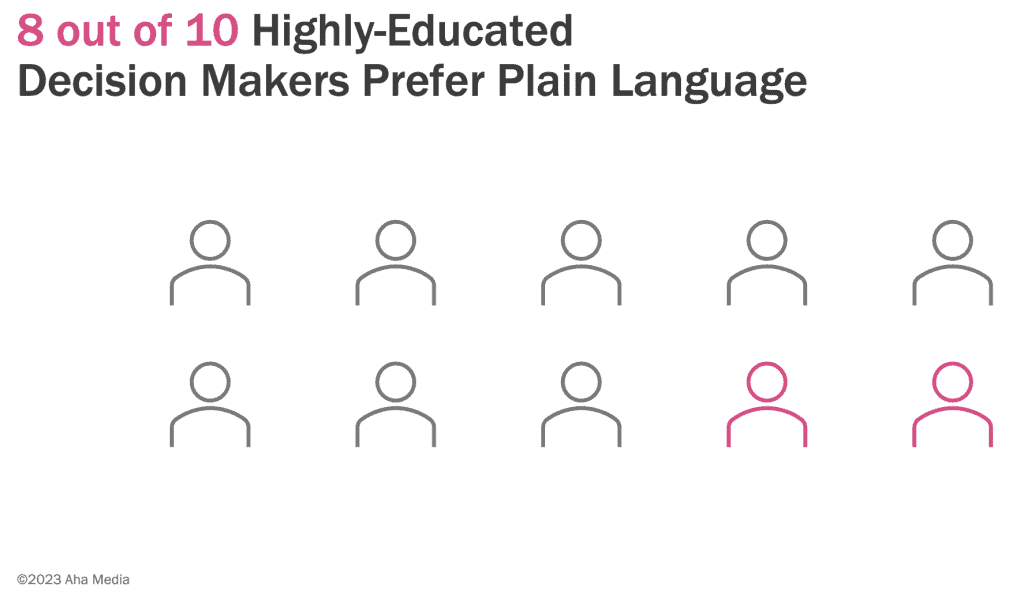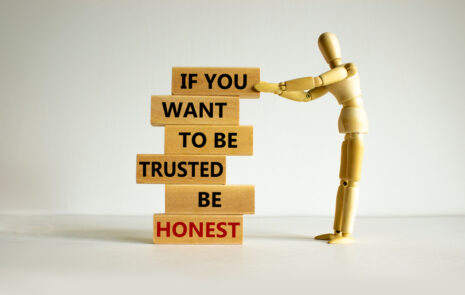
Who understands healthcare content?
Facing a life-threatening illness, Ahava Leibtag combed the Internet for every single bit of information about her condition. But the content she found didn’t help because:
- It was too hard to understand.
- It took a purely clinical point of view.
- It completely lacked empathy.
- And some content contradicted other content.
Eventually, Ahava discovered a research article by a doctor who figured out her condition. But then her condition turned chronic, requiring a new round of research.
Her experiences “made me very passionate about patients on the other end of the screen, or caregivers, or family members who are trying to find information and they can’t understand it,” Ahava says.
Make complex ideas understandable
At her healthcare content agency Aha Media, Ahava champions plain language that people understand.
“So, I did a lot of work around healthcare, making things understandable to people. It’s not just when we’re talking about your own health, but also how to pay a bill, what a hospital stay is, what the expectations are around diagnostics? What’s it like to be inside an MRI machine?”
She investigated how healthcare providers can better communicate with patients, friends, and families. She found out that people want to receive information in a calm way, to feel their questions are answered, and to make sure they understood what they heard.
Patients struggle to fathom healthcare content
She discovered that 9 out of 10 adults struggle with routine health information. Why?
When people find new information that confuses them, they feel helpless and hopeless. People get angry, seek to escape, or freeze up.

“When people are reading or watching or listening to content, we want them to feel empowered to make a decision,” Ahava says.

“And the only way to do that, I think, is for the emotional side to really be as calmed down as possible. They talk about it in the lizard brain – it’s fight or flight.
“And both of those are probably not the right decision when it comes to healthcare. You don’t want to ignore it, and you also don’t want to start fighting about it. So that’s what we’re trying to do,” Ahava says.
That’s why healthcare information needs to be completely clear. For example, professionals need to speak the patient’s language. Patients who don’t know terms such as hypertension do know what high blood pressure is.
Most doctors have not been trained to communicate with patients effectively.
But patients need to hear health information in plain language. Because more than two out of five Americans (43%) are “functionally illiterate.” About 93 million Americans read at or below a basic level that empowers them to contribute successfully to society.
Plain language helps people succeed
This graphic shows what plain language is all about and why it’s all-important:

Plain language helps people:
- Find what they need.
- Understand what they find.
- Use what they find to decide how to move forward.
Ahava coaches clients to help them understand patients’ information needs and how they differ from healthcare professionals’ needs.
Consumers clearly prefer plain words. With plain language, clients gain a competitive advantage – clarity.
But that begs the question:
Do experts prefer plain words?
In 2023, Aha Media fielded a research study to find out how much difference plain language makes to doctors and other healthcare professionals.

The study found that 8 out of 10 (80%) highly educated healthcare decision-makers prefer plain words.
Why are plain words better, even when your audience consists of specialized experts?
Because plain words save time. “It takes less work to unpack the message … What we are short on is time. Concise messaging is better,” a study participant said.
A similar study by Crocstar in the UK found that lawyers prefer plain language. Plain language works because it helps people make choices and take actions.
Clarity drives people to act
Aha Media’s research tested before-and-after examples of business to business (B2B) content that healthcare professionals use.
First, professionals read existing healthcare content. Then they read the same content, freshly rewritten in plain language.
The research tested three specific pieces of content:
- One test involved a “Why Choose Our Company?” webpage. Based on the original content, only 1 out of 3 professionals (35%) said they’d reach out to the company.
But when it used plain words, 2 out of 3 professionals (68%) said they’d reach out to the same company – almost double the response rate! - A second test focused on a telehealth description. Half of professionals (50%) said the original version was easy to understand.
After a plain word rewrite, 9 out of 10 (89%) found it easy to understand – almost double the original response!
When the description became easier to understand, the likelihood of a professional’s request for a demo increased from 44% to 73%. And 3 out of 4 professionals (76%) preferred the plain word example. - A third test involved a white paper download. Only 15% of professionals found the original content easy to understand. But the plain word version was easily understood by 66% of professionals – more than a fourfold increase!
As a result, professionals were 3 times likelier to download the white paper (68% vs. 22%). And 4 out of 5 (82%) preferred the plain word version.
When results from these 3 tests were combined, less than half of healthcare professionals (47%) considered the existing content clear. Yet 3 out of 4 (76%) found the rewritten plain language examples clear. And 4 out of 5 preferred plain language.
How to make your content even clearer
What’s one trick that writers and marketers should use to pursue plain language?
“It’s one of the oldest tricks. The most important tool that writers have to decide if something is plain language is reading their content out loud,” Ahava says.
“Reading fluency is actually a combination of two things:
- Can your eye and your brain make sense of the symbols that the letters make and the sounds associated with those symbols?
- And how does it sound? This is called prosody. Does it have a musical component to it? That’s really what punctuation is, a tool designed to create that prosody in our mind when we’re reading, just like sheet music has notes.”
When your content looks good and sounds good, you know it’s ready to go.
Here are detailed findings from Aha Media’s research.
And here is Ahava Leibtag’s LinkedIn biography.
Related Posts
Presenting? Read these tips to help you improve.
You’ve been asked to give a presentation, and it’s a great chance to get your company’s story heard. But whether it’s for an internal...
Marketers Prove Curious about Messaging, Content, and Presentations in 2023
Thank you for being among thousands of marketers who read our blogs. Your reading habits revealed which topics you’re most interested in this year....
A Truthful Message Leads Your Audience
When you create your strategic message, the sixth pitfall to avoid is creating a message that’s misleading. This may seem obvious, but it happens...
“How can teams with limited resources be best structured to impactfully address content needs?”
A marketer from Blackrock asked: “How can teams with limited resources be best structured to impactfully address content needs?” Limited resources: a blessing or...





